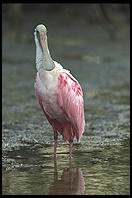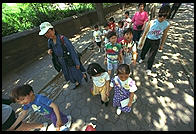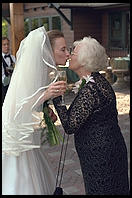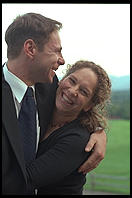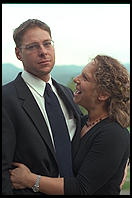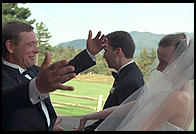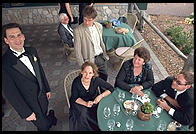
Canon EOS Digital SLR System
a photo.net guide
The Canon EOS system of digital single-lens reflex (SLR) bodies and lenses is the standard choice among professional photographers worldwide. This page makes it easy to shop for Canon digital bodies and EOS lenses. Every component manufactured by Canon is covered, plus a few exceptionally good third-party components. If you are new to photography, you might want to start with our article "Building a Digital SLR System".
This article goes through every section of the Canon EOS system and concludes with some starter system recommendation
Canon EOS Bodies

Small sensor bodies are good for telephoto work, such as wildlife photography. A 100mm telephoto lens that would be ideal for portraits on a film or full-frame sensor body gives a 150mm equivalent perspective on a small sensor ("APS-C") body. The full-frame sensor bodies are good for wide angle photography, low-light photography, and ultimate image quality.
Small sensor
- Canon Digital Rebel XTi (Black) (review), introduced October 2006, the right camera for most consumers who want a responsive accurate machine (replaces the similarly named, but obsolete, Canon Digital Rebel XT, $444 (review))
- Canon Digital Rebel XSi, $640 (review), the new replacement for the Rebel XTi
- Canon EOS 40D, $850 (review), larger and heavier than the Rebel with comparable image quality and capabilities, but more convenient controls; great camera for wildlife and sports photography
- Canon EOS 50D, $1199 (review), an upgrade to the EOS 40D, which includes Live View
- Canon EOS 1D Mark III, $3845 (review), the ideal camera for professional sports photographers
- Sigma 30/1.4, $439, ultrasonic motor, equivalent to a 45mm perspective on a film or full-frame camera; Canon does not bother to make a competitive lens
- full-frame sensor (EOS 5D)
- Canon EF 50mm f/1.4 USM, $400 (review), includes an ultrasonic motor that allows simultaneous use of manual and autofocus, high quality (metal) mechanical construction
- Canon EF 50mm f/1.8 II, $93 (review), cheap plastic case, high image quality, no ultrasonic motor and therefore autofocus is slower, noisier, and harder to override with a manual twist
- S 17-55 f/2.8 IS USM, $960 (review), if you have a small sensor and must have a midrange zoom, this is the one to get; f/2.8 and L-class image quality would make it a good lens; image stabilization makes it a great lens
- Canon EF-S 17-85mm f/4-5.6 IS USM, $465, image stabilization will enable you to handhold slower shutter speeds indoors and therefore despite the slow maximum aperture, you might not have to use flash all the time--you will still suffer with a dim viewfinder
- Canon EF-S 18-55mm f/3.5-5.6 USM (review), the "kit" lens that Canon tosses in with most of Digital Rebels sold, works well enough outdoors on bright sunny days
- Canon EF 24-70mm f/2.8L USM, $1190 (review), heavy, but very high quality and the ultimate wedding reception tool
- Canon EF 24-85mm f/3.5-4.5 USM, $322 (review)
- Canon EF 24-105mm f/4 L IS USM, $1099 (review), much lighter than the 24-70, but still superb optical quality, the loss of one f-stop compensated for somewhat by the provision of image stabilization
- Canon EF 28-80mm f/3.5-5.6 II, $150, cheap "kit" lens designed for the film Rebel
- Canon EF 28-90mm f/4-5.6 II USM, $98 (review), cheap "kit" lens with a faster quieter autofocus
- Canon EF 28-105mm f/3.5-4.5 II USM, $210 (review), reasonably cheap, reasonably good for outdoor use
- Canon EF 28-105mm f/4-5.6 USM, $149 (review), spectacularly cheap, spectacularly crummy
- Canon EF 28-135mm f/3.5-5.6 IS USM, $410 (review), average image quality, image stabilization useful if you must take pictures from an unstable platform, such as a boat
- Canon EF 28-200mm f/3.5-5.6 USM, $345, convenient range, acceptable image quality if used on a tripod and stopped down to f/8
- Canon EF 28-300mm f/3.5-5.6L IS USM, $2399 (review), incredibly heavy, exceptional range, reasonably good quality, image stabilizer enables handheld use at longer focal lengths without the use of a tripod or flash Canon EF-
- Canon EF-S 10-22mm f/3.5-4.5 USM, $699 (review), a touch slow, but dramatically wide
- Canon EF 16-35mm f/2.8L USM, $1399 (review), zoom from very dramatic (16mm) to boring (35mm) wide angle
- Canon EF 17-40mm f/4L USM, $699 (review)
- Canon EF 20-35mm f/3.5-4.5 USM
- Canon EF 55-200mm f/4.5-5.6 II USM, $150, cheap, slow, and crummy
- Canon EF-S 55-250mm f/4.0-5.6 IS, $255 (review), Canon's latest zoom IS lens
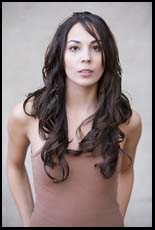
- Canon EF 70-200mm f/2.8L IS USM, $1599 (review), the image-stabilized version of the classic 70-200 zoom lens, good for portraits and stretchable with a Canon EF 1.4X II Extender, $310 (review)
- Canon EF 70-200mm f/2.8L USM, $1249 (review), just as good (and heavy) optically, but without image stabilization
- Canon EF 70-200mm f/4L USM, $600 (review), a good lens for travel, especially given the digital camera's ability to be reset for a higher ISO speed; too bad that it doesn't come with image stabilization
- Canon EF 70-200mm f/4 L IS USM, $1050 (review), all the same details as the previous lens but includes image stabilization
- Canon EF 70-300mm f/4-5.6 IS USM, $549 (review), remember that these slow maximum aperture lenses aren't good for stopping action, even if the image stabilizer cuts down on camera shake; sports photography would require a maximum aperture of f/4 or f/2.8 rather than the f/5.6 this lens provides
- Canon EF 70-300mm f/4.5-5.6 DO IS USM, $1190 (review)
- Canon EF 75-300mm f/4-5.6 III, $160
- Canon EF 75-300mm f/4-5.6 III USM, $200
- Canon EF 80-200mm f/4.5-5.6 II, $146
- Canon EF 100-300mm f/4.5-5.6 USM, $295
- Canon EF 100-400mm f/4.5-5.6L IS USM, $1400
- Sigma 300-800/5.6 HSM, $9999, ultrasonic motor, good for covering an airshow where you need the range and don't have time to switch focal length
Full-frame sensor
Canon EOS 5D, $2000 (review), the best camera for most advanced amateurs and professionals
Canon EOS 5D Mark II (review), with 21MP and HD video capabilities—do more with a camera than you have ever been able to before
Canon EOS 1Ds Mark III, $6999 (review), same size and weight as a brick; weather-sealed against rain and dust
For nostalgia buffs, Canon still makes some film bodies that work with all of the lenses below, except those marked "small sensor only". And older Canon film bodies that
Canon EOS-1V Professional SLR Body, $1650 (review), fully weather-sealed professional body with 100 percent viewfinder coverage
Canon EOS-3 35mm SLR Camera (Body Only), $945 (review), just about as useful as the 1V, without the 100-percent viewfinder
Canon EOS Elan 7ne 35mm Film Body, $343, bulkier than the Rebel with a rear control wheel just like the big Canon bodies
Canon Rebel T2, $205, pair with Canon EF 50mm f/1.8 II, $93 (review), for a cheap, light, high-quality, general-purpose camera
Canon EOS Rebel K2, $130, pair with Canon EF 50mm f/1.8 II, $93 (review)
An EOS-3 is good enough for almost any photographic purpose, it is incredibly rugged, and you should be able to buy one cheap in the photo.net classifieds.
An EOS-3 is good enough for almost any photographic purpose, it is incredibly rugged, and you should be able to buy one cheap in the photo.net classifieds.
Nomenclature
F-number: lower is better.
IS is "image stabilization", a technology lifted from camcorders in which the camera electronically compensates for unsteady hands. IS is especially important at long focal lengths, e.g., 200mm and above, because the lens magnifies camera shake at the sa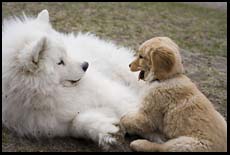 me time it is magnifying the subject. An IS lens will allow you to use slower shutter speeds without introducing camera shake. The alternative to an IS lens would be mounting the camera on a tripod or using a high ISO setting, which reduces image quality but allows the use of higher shutter speeds.
me time it is magnifying the subject. An IS lens will allow you to use slower shutter speeds without introducing camera shake. The alternative to an IS lens would be mounting the camera on a tripod or using a high ISO setting, which reduces image quality but allows the use of higher shutter speeds.
USM is "ultrasonic motor". All Canon EOS-system lenses have built-in focus motors. There is no motor in the body as is the case with Nikon, for example. The cheaper Canon lenses have a motor that must be clutched out with a switch if the photographer wishes to focus manually. When using a USM lens, the photographer can push the shutter release (or a button on the rear of the camera, if a custom function is set) and let the autofocus system do its best, then touch up the focus manually by twisting the lens ring.
The L lenses are Canon's expensive lenses designed for professional photographers. An L lens will always have good optical performance, even if it is a wide-range zoom that is challenging to design. An L lens will always be mechanically tough and well-sealed against water and dust. An L lens might be very heavy and expensive. Note that there are some non-L prime (fixed focal length or non-zoom) lenses, such as the 50/1.4, that offer extremely high optical quality. The non-L Canon zoom lenses are optimized for light weight and low cost and won't be especially high in optical quality.
EF-S lenses are designed for Canon's small-sensor digital cameras, such as the Digital Rebel. The "EF" in "EF-S" is the standard Canon EOS "Electro-Focus" mount, introduced in 1987. The "-S" stands for "short back focus" and means that the lens design protrudes more deeply into the camera body. This protrusion would damage a full-frame camera's mirror, so a mechanical interlock prevents these lenses from being mounted on a standard EOS camera. An EF-S lens will work with any of the small-sensor bodies introduced since 2003, including the original Digital Rebel (300D) and the 20D.
Normal Lenses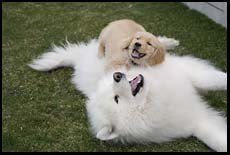
A normal or standard lens is light in weight and approximates the perspective of the human eye. Normal lenses have large maximum apertures, indicated by small f-numbers such as f/1.4 or f/1.8, and thereby gather much more light than zoom lenses. It may be possible to take a photo with a normal lens in light only 1/8th or 1/16th as bright as would be required for the same photo with a consumer-priced zoom lens. Another advantage of the large maximum aperture is that the viewfinder will be correspondingly brighter and therefore easier to use in dim light. (SLRs keep the lens wide open for viewing and stop down to whatever aperture you have set just before taking the picture; this is why the viewfinder always looks the same even if you switch from f/1.4 to f/8 to f/16
small sensor (Rebel and 30D)
In terms of flare, contrast, and sharpness, these are the highest quality lenses that you will ever attach to your camera. If you can do the job with a 50/1.4, as many of the 20th Century's greatest photographers did, you can save yourself a lot of weight and cost. There are good zoom lenses, mostly in the Canon L series, but they are very expensive and heavy..)
Wide-to-Telephoto Zoom Lenses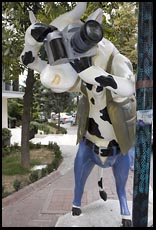
A wide-to-tele zoom is what you get as a standard "kit" lens with a cheaper digital SLR body. The range goes frommoderately wide through normal to moderately telephoto. They are good when you are too busy to change lenses, e.g., at a wedding reception. The 24mm perspective (full-frame) will capture a table of guests; the 70mm or 105mm long end is good for a flattering portrait. The main weakness of these lenses is that the cheaper ones have a very small maximum aperture, e.g., f/4 or f/5.6, and can only be used in bright light, on a tripod, or with a blast of on-camera flash that gives everyone a moon face.
Digital-only
Full-frame
Here are a few photos from my brother's wedding, taken with a discontinued Canon 28-70/2.8L (superseded by the
Wide-angle Zoom Lenses
Good for general-purpose dramatic wide angle photography. More distortion than wide-angle prime lenses, which makes them less suitable for photographing architecture (though many kinds of distortion can be fixed by a PhotoShop wizard).
small sensor (Rebel and 30D)
Full-frame sensor
Telephoto Zoom Lenses
These are good complements to a normal lens when traveling. The long end may not be useful indoors due to a small maximum aperture.
small-sensor only
full-frame
Interesting third-party lenses:
